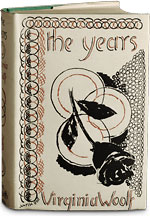The Bloomsbury Aesthetic
The canonization of Bloomsbury is a curious thing. As the exhibit and catalog together point out, Americans have always had a curious relationship with the group. In another catalog essay, “Virginia Woolf in America,” Mark Hussey observes that Americans adopted Woolf more readily than their literary counterparts in England. The English were inclined to view Woolf’s privileged background and socialist leanings more as inchoate confusion than the product of a curious and complex intellect. But as Hussey also points out, in this country Virginia Woolf was first offered up as a reductive feminist icon, and later, particularly in the film The Hours, not simply as a depressive, but one who was “frail, homely, dour, alienated, and suicidal,” all at the expense of her persona as a confident writer, prolific diarist, and vibrant social figure.
Surely the Bloomsbury soil is so fertile that it allows us to simply gather and cultivate those particular shoots and sprouts we find most appealing. The group’s balancing act of insularity and expansiveness, while perhaps dazzling, is hard to take whole cloth, so instead we cut out those pieces and patches that we find most engaging. And in doing so, the distinctions we make conform to our own particular prejudices. And so it goes that every letter, every sketch, every journal entry is generally met by the American Bloomsbury industry with an orgy of breathless enchantment.
If our compulsion to take some narrow strain and imagine it speaks for the whole limits the view, “A Room of their Own” begs a more measured and discriminating perspective. Given that we are going to pick and choose anyway, this show encourages viewers to consider the particulars of Bloomsbury in a more thorough and disciplined way—surely what those artists and writers, brilliant and maddening in all their self-contradiction, deserve. It asks, for example, to what degree the lives of these artists and writers conformed to the strictures of Victorian era from which they came. And given that this exhibition is shaped by the perspective of the collector, how did it come to be that in the 1970s and 1980s The Reader’s Digest owned the largest American collection of Bloomsbury art?
In a piece last winter in the New York Times, the critic Holland Cotter noted that university museums are uniquely positioned to take on subjects “too specialized or unglamorous or experimental to find a home in public art institutions.” Such museums, he suggested, offer “a model for small, intensely-researched, collection-based, convention-challenging exhibitions” out of reach to larger institutions more financially determined to produce massive, crowd-pleasing blockbusters. “A Room of Their Own” is just such an exhibition.
“A Room of Their Own: The Bloomsbury Artists in American Collections” was organized by the Herbert F. Johnson Museum of Cornell University. The exhibition opened at Duke University’s Nasher Museum of Art and is now headed to the Herbert F. Johnson Museum at Cornell University (July 18-October 18). The show then travels to the Mills College Art Museum (November 7-December 13); the Mary and Leigh Block Museum at Northwestern University (January 15-March 14, 2010); the Smith College Museum of Art (April 3-June 15, 2010); and the Palmer Museum of Art at Penn State University (July 6-September 26, 2010). A comprehensive hardbound exhibition catalog is available at the museums.















 Akiko Busch writes about design, culture, and the natural world. She is the author of Geography of Home: Writings on Where We Live and The Uncommon Life of Common Objects: Essays on Design and the Everyday. Her most recent book, Nine Ways to Cross a River, a collection of essays about swimming across American rivers, was published in 2007 by Bloomsbury/USA. She was a contributing editor at Metropolis magazine for 20 years, and her essays have appeared in numerous national magazines and exhibition catalogues. She has taught at the University of Hartford and Bennington College and has appeared on public radio in the U.S. and Canada. Currently she a regular contributor to the New York Times Sunday regional section and teaches at the School of Visual Arts in New York City. She lives in New York’s Hudson Valley with her husband and two sons.
Akiko Busch writes about design, culture, and the natural world. She is the author of Geography of Home: Writings on Where We Live and The Uncommon Life of Common Objects: Essays on Design and the Everyday. Her most recent book, Nine Ways to Cross a River, a collection of essays about swimming across American rivers, was published in 2007 by Bloomsbury/USA. She was a contributing editor at Metropolis magazine for 20 years, and her essays have appeared in numerous national magazines and exhibition catalogues. She has taught at the University of Hartford and Bennington College and has appeared on public radio in the U.S. and Canada. Currently she a regular contributor to the New York Times Sunday regional section and teaches at the School of Visual Arts in New York City. She lives in New York’s Hudson Valley with her husband and two sons.